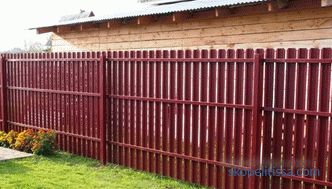Everyone wants to live outside the city in a private well-maintained house and enjoy all the fruits of civilization. But, unfortunately, not all suburban settlements have centralized communication networks. Therefore, the owners of suburban real estate are taking all steps to acquire them, at least in standalone performance. This applies primarily to the plumbing. But the topic of the article is not about this, but about how to choose the right filter for water purification from the well in the country. Because an autonomous water supply system is a water intake from a well or a well, in which water does not always meet sanitary standards. Therefore, we consider the filters that are used today for water purification, as well as tell about their characteristics and operating principles.
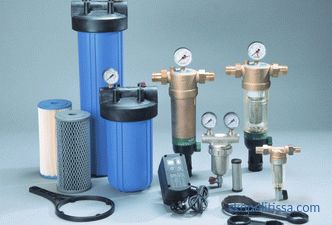
How to determine the quality of well water
The ideal option is to transfer water to laboratory analysis, which will reveal its transparency, infection with bacteria, the presence of salts, metals and other troubles. But the easiest way to determine whether water is suitable for drinking and home use is to pour it into a transparent container and see what has become of it in a couple of hours. If the transparency has not become higher, if a thick layer of sediment has formed at the bottom of the dishes, if the water itself exudes unpleasant odors, then you should not use it.
Of course, it is necessary to inspect the well for its integrity. Usually muddy water appears only if the ground gets into it. Therefore, it is necessary to call the repairmen, who close up the seams between the elements of the well shaft and replace the bottom filter consisting of rubble.
If the color of the water is opaque, then disinfection is required. And also build a canopy over the hydraulic structure, which will protect the well from debris, precipitation and sunlight. By the way, it is the sun that contributes to the "blooming" of water.
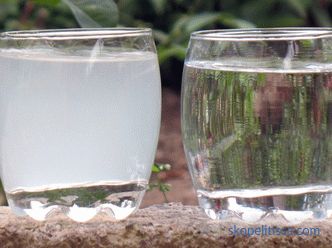
If the water from the well is brown or yellow, then this is a sign that there is a lot of water in it iron salts. And here no methods other than filtering will help.
That is, it turns out that building a well is an uneasy business, requiring certain financial investments, but it is a one-time. It is more difficult to organize water purification. And these are the same financial investments only constant, because filtering requires constant monitoring of the cleaning efficiency. And this is achieved only by replacing the filter elements.
But experts assure that the cleanliness of water from a well largely depends on the technical condition of the hydraulic structure itself. Therefore, at least once every five years, it must be repaired, because colonies of bacteria constituting mucus are formed on the walls, sealing the joints between the elements of the mine decreases, the bottom filter decreases in thickness. Therefore, water from the well is pumped out, the mucus is scraped mechanically, after which the walls of the mine are treated with disinfecting compounds, repairs are made to the joints, change or supplement the bottom filter.
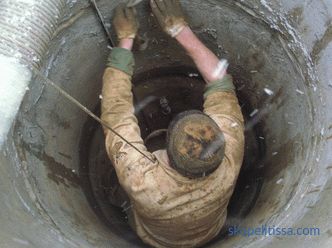
Autonomous water supply scheme
Before turning to the topic which filter for water to choose to give from the well, it is necessary to clarify what constitutes an autonomous water supply network. It consists of:
-
pump , through which water is supplied from the well to the house ;
-
piping ;
-
filter systems for water treatment ;
-
sometimes set up tank , in which water is collected for reserve .
In the system of such water supply, two types of pumping equipment are used.
Surface
They received their naming only because they were installed on the surface of the well, without dropping into the water. In the mine is lowered the hose or plastic pipe, equipped with a mesh filter. The latter is intended to hold large undissolved particles: pebbles, organic matter, garbage, sand, and so on.
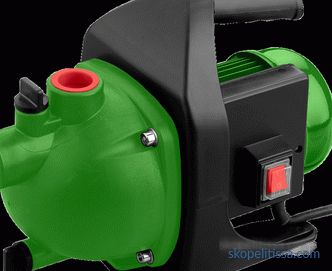
Since the water supply system is a system with constant non-seasonal operation, it is necessary to create all the conditions so that the pump is located in the insulated space. There are several options for this:
-
inside the well , where they construct a platform from metal profiles to which the pump and install;
-
hold assembly of the caisson , inside which mount the pump , part of the piping and locking fittings;
-
erect near the hydraulic engineering structure a heat-insulated construction that can be used additionally for domestic needs;
-
install a pump inside the house : either in a specially designated utility room , or in basement e .
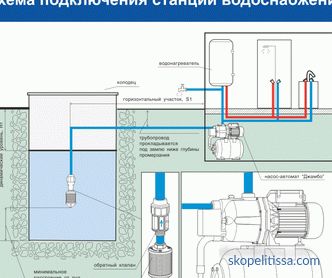
Submersible
From the name it becomes clear that this modification of water pumps is partially or completely immersed in water. That is, it is located inside the well, and the pipe itself is already diverted from the device directly into the house. The design of the submersible pump already has a strainer located on the suction inlet of the unit.
These are small-sized pumps, compact, but with a sufficiently large capacity that can provide water to a small country house. As for the pressure, these devices can not boast of a large indicator. Therefore, they are used for pumping water from a small depth (up to 10 m), which the wells possess.
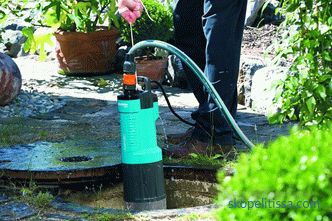
On our website you can find contacts of construction companies that own a full cycle of their own production, have services without prepayment , provide a loan or installments for the construction , and also take into account the funds of maternity capital . Directly to communicate with representatives, you can visit the exhibition of houses "Low-rise Country".
Filtration system
In this article we will not speak about the simplest water filters, which include jugs and special nozzles. With their help it is possible to purify only slightly polluted water that enters the house from the central water supply network. Our task is to tell about those devices that are struggling with strong pollution.
Coarse filter
In essence, this is the same mesh device, only it is more refined. That is, the grid (metal or synthetic) is enclosed in a housing that is cut into the pipe wiring after the pump. The main objective of this type of filter is to purify water from large impurities. Particle size is determined by the size of the grid cells.
It is this filter that holds sand, clay, small stones, pieces of sintered lime, scale, and other impurities. Most often it is made of stainless steel, in which holes are made in sizes from 50 to 400 microns. The smaller the hole, the more efficient the device works, that is, the cleaner it cleans water. Such devices have virtually no lifetime limit. They are reliable, rarely needing repair.
In this regard, filter devices with polymer cartridges (usually propylene) are reliable units, but they are fast clogged with dirt. Therefore, this group of filters is made with removable filter elements. After pollution, they are simply washed with water or replaced with new ones.
Manufacturers today offer coarse filters of different designs:
-
with a coupling or flange connection ;
-
straight or inclined ;
-
with or without flushing .
Skew and straight lines are distinguished by the fact that the mesh element in the form of a cylinder is first installed at an angle to the water flow, secondly perpendicularly. At the same time, there is a reservoir in the design of the device, which is the installation location of the mesh cylinder, which additionally performs the functions of the sludge collector. That is, large particles that have not passed through the grid are deposited on its bottom, and small particles of dirt settle on the bottom.
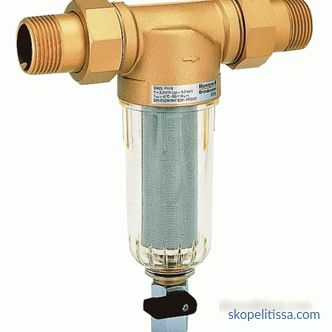
Among all known pre-filter types, there are washing types and non-washing ones. But the cartridges are mostly non-flush. How do they differ from each other. Wash - these devices, filter elements which are tightly sealed in the filter housing. That is, pull them out and rinse does not work. Washing on the contrary is easily understood, the grid is washed and installed in place for further use. We add that the washing model can be installed only on the horizontal sections of the pipe layout.
The video shows a coarse screen:
On our website you can find contacts of construction companies that offer water and sanitation services in including wells. Directly to communicate with representatives, you can visit the exhibition of houses "Low-rise Country".
Fine filter
They are also called pre-filters and are installed after the device with a rough cleaning. Their main task is to create obstacles for small undissolved particles. The latter slaughtered household appliances, quickly disabling them. On the market, this type of water filter is represented by two modifications:
-
with a metal grid , in which the diameters of the holes range from 30 to 50 microns;
-
polypropylene cartridges , consisting of fibers that retain undissolved particles, even 5 microns in size.
The first group is a few models in the wash filter category. Today, manufacturers offer self-washing structures, in which the grid is washed under the pressure of flowing water, and contaminants are washed down the drain. That is, such devices are cleaned without removing the filter element.
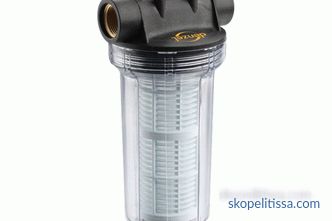
Cartridge models are not subjected to washing. That is, they can not be removed, washed and put in place. The filter element is necessarily replaced by a new one. But these models have other positive properties depending on what loads are placed on it. For example, activated carbon is put into polypropylene fibers or silver is added in the form of threads. In this way, disinfection of water occurs. Today, some models of fine filters lay ion exchange resins.
It should be noted that the requirements for mounting these devices are quite stringent, so self-installation is not recommended. In addition, it is very important to choose the filter unit to the pressure and performance of the autonomous water supply network. Otherwise, the filter will not work effectively.
In the video a specialist talks about the fine filter:
Trunk filters
The group of prefilter filters includes devices, which are called trunk. They got their name only because they crash into the main pipe of the autonomous water supply system. This is a bubble-shaped device, the body of which is made of steel or plastic. The device itself is collapsible, because a filter element is installed inside the bulb.
Most importantly, the main filters easily purify water that flows through pipes with a decent speed - 20-50 l / min. At the same time, they retain not only impurities, but also chlorine, from which the water gets a pleasant taste.
In the market, filters of this type are represented by a huge variety:
-
according to the degree of purification ;
-
according to flow power water ;
-
according to the type of case and cartridge ;
-
by the level of hydraulic losses ;
-
by the temperature of the liquid that flows inside the device.
The last position is important because there are filters for cold water and for hot. The first can be used as a water filter to give from the well. But the second set with hot water at home is impossible.
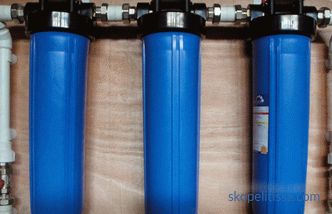
It might be interesting! In the article on the following link, read about plumbing in the country from the well: 3 main criteria for choosing a system.
There is one more classification of the main filters:
-
single-stage instruments, by means of which water is purified from impurities, small organics , rust ;
-
two-step , which, in addition to the impurities described above, easily remove chlorine and unpleasant odor ;
-
the three-step additionally perform the functions of the softeners , that is, iron is removed from the ode.
As for the filtering elements, here again, manufacturers offer several positions: mesh, fibrous winding, fibrous chaotic, corrugated and granular loading. The latter are crumbs made of various types of stone, anthracite, expanded clay, quartz sand, and so on.
The video provides an overview of the main water filters:
This may be interesting! In the article on the following link read about water supply of a private house from a well.
Softeners or filters for cleaning iron
To begin with, this type of filter is installed only if a large amount of iron is found in water. On Earth, there are four known states of iron in nature: bivalent, trivalent, colloidal and organic. It is the first two that are often found in the water from the well. So ferric iron can be removed with a coarse filter, and even more so with a preliminary (fine) filter.
But for bivalent iron, special filtering units will be required, for example, with a charging element of a multi-component mix. There are two types of softeners on the market:
-
chemical using special reagents;
-
physical - without reagents.
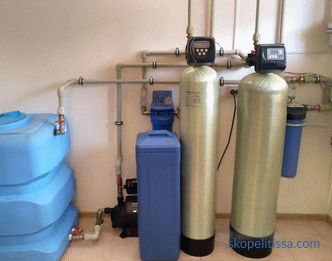
The first are devices that use liming technology ion exchange and flotation, which is carried out under great pressure. The second group includes units with the following water purification technologies: electrocoagulation, single or double aeration, dry filtration.For water, which will later be used for drinking and domestic needs, apply non-reagent technology.
It is impossible to cope with the bacterial iron mesh filters. And the usual methods of disinfection will not work here. For this, purification technologies are used at the molecular level, which include reverse osmosis devices. There is another option - coagulation.
The video shows a water filter as a cheap and reliable option for cleaning water from iron:
This could be interesting! In the article on the following link read about the plots without a contract - how not to become deceived.
The reverse osmosis filtration system
This is the most modern approach to filtering water from wells. It is also the most effective, because it cleans by 99%. Other filters can not boast of such indicators. In the device itself, water passes several degrees of purification, and a liquid appears at the output, which in its performance does not yield to the drinking water produced by the best producers.
So, the reverse osmosis system consists of:
-
pre-treatment of water , where small impurities and chlorine are removed, the process itself has a three-step process and is carried out three flasks mounted in series;
-
membrane filtration type is a perforated membrane in which holes with a diameter of 0.0001 microns are made over the entire area.
The main element is the membrane. It works on an interesting principle. Water under pressure is supplied to it, and through the holes passes into the next compartment in the form of molecules. But all known impurities cannot pass through such small holes. This is how cleaning happens. But there is one serious requirement for the reverse osmosis system - the filter will work only if water is supplied to the membrane under a pressure of at least 1 atm. If this is not adhered to, then the liquid cannot pass through the holes. But since the autonomous water supply network is primarily a pump, water pressure inside the system can be guaranteed.
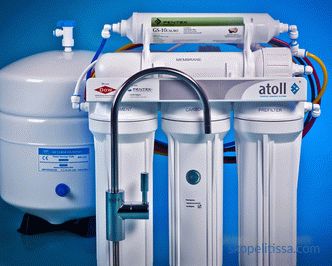
As for the three-stage pre-cleaning, the first flask is a pre-cleaning filter that passes undissolved impurities of size no more than 5 microns. The second flask is a device filled with activated carbon, with which organic matter and chlorine are retained. And the third flask is a fine filter that holds undissolved particles with a diameter of not more than 1 micron.
A reverse osmosis filter is a rather bulky product that is usually installed in a cabinet under a sink. Today, manufacturers, trying to increase the quality of drinking water, complete the filter with a so-called mineralizer, which is filled with tourmaline balls. This mineral saturates water with sodium, magnesium and calcium.
In the video, the specialist talks about how the reverse osmosis filter works, what are the requirements for its installation:
This may be interesting! In the article on the following link read about the house "four seasons" - the combination of high-tech style and elegant landscape design.
Conclusion on the topic
As you can see, a large number of different filtering devices are required to bring the water from the well to the degree of "drinking". As practice shows, not all of the above are used by summer residents in the autonomous water supply system. But two of them establish a mandatory: coarse and fine filter. In many cases this is enough. But here we must take into account the chemical state of water. That is why experts recommend doing its analysis in the laboratory.



